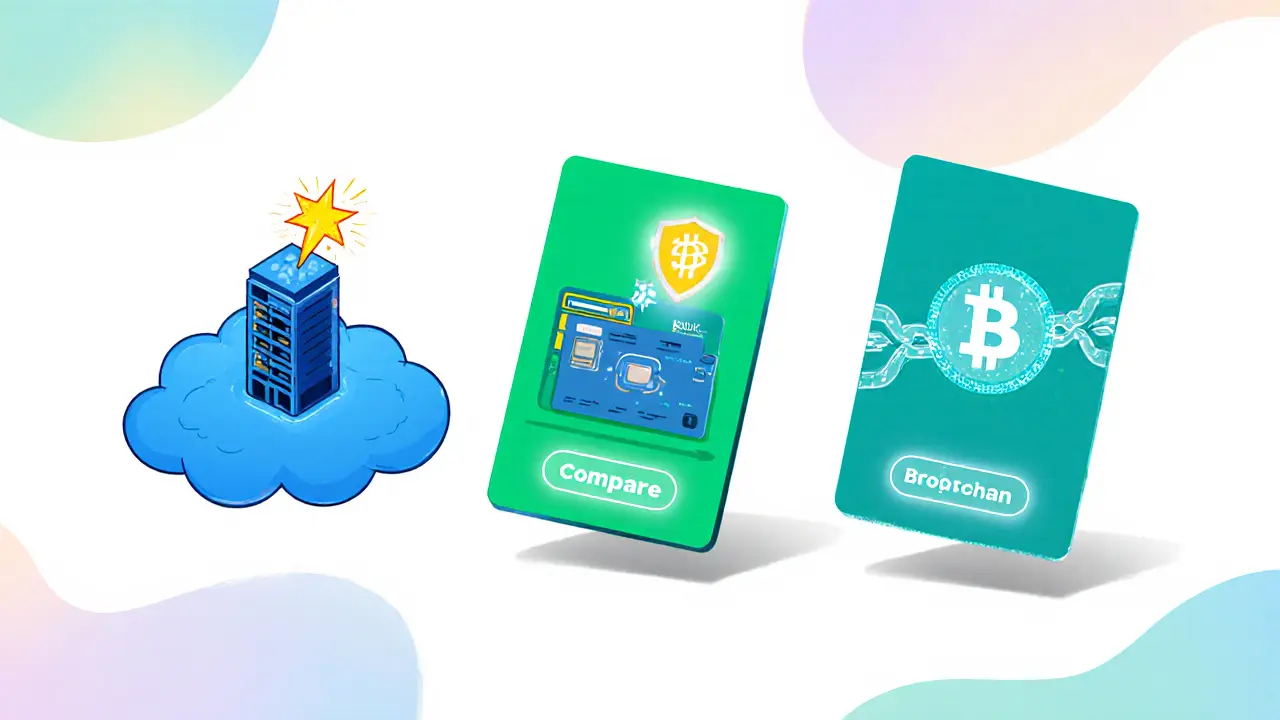BaaS Provider Comparison Tool
Backend as a Service
Cloud platforms for server-side logic and databases
Banking as a Service
Regulated financial services for embedded finance
Blockchain as a Service
Deploy distributed ledgers without devops overhead
Select a category above to compare providers based on key criteria.
Backend as a Service (BaaS) is a cloud platform that handles server‑side logic, databases, authentication and real‑time features so developers can focus on the front end. In 2025 the term BaaS also covers Banking as a Service and Blockchain as a Service, three overlapping but distinct ecosystems that power everything from mobile apps to fintech wallets and enterprise blockchain pilots.
Quick Takeaways
- Firebase and AWS Amplify keep leading the Backend market, while open‑source Supabase gains traction.
- Solarisbank and Treezor dominate European Banking‑as‑a‑Service, with Itexus expanding globally.
- Rapid Innovation, Blockstream and Kaleido are the go‑to names for Blockchain‑as‑a‑Service in 2025.
- Key selection criteria: scalability, security certifications, API depth, and transparent pricing.
- Look for providers that bundle compliance tools (KYC, AML) to avoid costly add‑ons.
Backend as a Service - Who’s on Top?
When you need a ready‑made backend, the market splits into three camps: cloud giants, specialised SaaS platforms, and open‑source projects you can self‑host.
| Provider | Core Services | Pricing Model | Typical Users |
|---|---|---|---|
| Firebase | Realtime DB, Auth, Hosting, Analytics | Freemium → pay‑as‑you‑go, caps at $0 for hobby tier | Start‑ups, mobile games, web MVPs |
| AWS Amplify | Auth, GraphQL/API, Storage, CI/CD | Pay‑per‑request, scale‑with‑usage | Enterprises, serverless‑first dev teams |
| Supabase | PostgreSQL, Realtime, Edge Functions | Free tier + flat‑rate plans (starting $25/mo) | Open‑source lovers, SaaS builders |
| Backendless | Codeless UI, Cloud & On‑prem, Push, Geolocation | Tiered subscription, 30‑day free trial | SMBs needing rapid rollout |
| Appwrite | Self‑hosted, Functions, Storage, Webhooks | Open source, hosting cost only | Teams with DevOps control |
Why does Firebase still dominate? Its realtime sync and zero‑config auth let a developer ship an MVP in a weekend. AWS Amplify wins with deep integration into the broader AWS ecosystem-perfect when you already run Lambdas or DynamoDB. Supabase’s open‑source roots appeal to privacy‑first startups that dislike vendor lock‑in.
Banking as a Service - The Power‑Behind‑Embedded Finance
Embedded finance is no longer a buzzword; it’s a revenue driver. The biggest BaaS players bundle bank‑grade accounts, card‑issuing, KYC, and compliance APIs behind a single developer portal.
| Provider | Geographic Reach | Key Offerings | Regulatory Status |
|---|---|---|---|
| Solarisbank | EU + APAC pilots | Digital accounts, card‑issuing, lending, compliance suite | Full German banking license, passport across 25 EU countries |
| Treezor | Europe (25+ countries) | SEPA processing, e‑wallets, API‑driven payments | EMI license via Societe Générale |
| Itexus | Global (US, EU, LATAM) | Custom fintech stacks, payment gateways, fraud protection | Multiple partner bank licences, PCI‑DSS compliance |
| ClearBank | UK & Ireland | Instant settlement, API‑first core banking | UK authorised bank, FCA regulated |
| Bankera | Lithuania & EU | Crypto‑friendly payments, P2P, e‑commerce | EU e‑money licence, AML/KYC suite |
Solarisbank’s licence gives it a “passport” advantage-any app can open a German‑regulated account without a local bank. Treezor leans heavily into SEPA and e‑wallet APIs, making it the go‑to for European marketplaces. Itexus differentiates with fully customisable stacks, which is why many cross‑border fintechs pick them for rapid market entry.

Blockchain as a Service - Deploy Distributed Ledgers Without the Headache
Enterprises wanting to experiment with Web3 no longer need a full dev‑ops team. BaaS providers now host Ethereum, Hyperledger, Bitcoin, and even proprietary consensus layers.
| Provider | Supported Protocols | Unique Feature | Typical Deployments |
|---|---|---|---|
| Rapid Innovation | Ethereum, Polygon, Solana | 90‑day guaranteed live deployment, hourly rates | MVP blockchain apps, token launches |
| Blockstream | Bitcoin, Liquid Network | Satellite API delivering block data globally | High‑frequency trading, satellite‑linked wallets |
| Kaleido | Ethereum, Hyperledger Fabric, Corda | Multi‑protocol business cloud, governance tools | Supply‑chain traceability, consortium ledgers |
| Bloq | Enterprise‑grade Ethereum | Dedicated node management, compliance dashboard | Financial services, regulated tokenization |
| tZERO | Security Token Platforms | Integrated secondary market for token trading | Capital markets, digital securities |
Rapid Innovation’s 90‑day guarantee is a big draw for startups that can’t afford months of dev‑ops delays. Blockstream’s satellite service appeals to developers building apps for remote or off‑grid users. Kaleido remains the most versatile for consortia, thanks to its multi‑protocol UI.
Choosing the Right Provider - A Practical Checklist
With dozens of options, a systematic approach saves time and money. Use the checklist below to narrow the field.
- Scalability: Does the platform support auto‑scaling from 100 to 1million daily active users without manual re‑config?
- Security & Compliance: Look for ISO‑27001, SOC2, PCI‑DSS, GDPR, or local banking licences depending on your data jurisdiction.
- API Depth: Are there SDKs for your language stack? Do they cover webhooks, batch jobs, and real‑time streams?
- Pricing Transparency: Avoid hidden egress fees. Prefer flat‑rate or per‑call pricing that matches your traffic pattern.
- Support & SLA: Does the provider offer 24/7 live chat or dedicated account managers? What’s the uptime guarantee?
- Vendor Lock‑in: Can you export data or migrate to another provider with minimal friction?
Plug your answers into a simple matrix and rank providers in each BaaS category. The highest total score usually points to the best overall fit.
Price‑Performance Snapshots - What You’ll Actually Pay
Below are ball‑park numbers for a typical SaaS product handling 10k daily users. Prices are per month, based on publicly available tier‑pricing as of October2025.
- Firebase: Free tier + $25 for additional storage & auth calls → roughly $30/mo.
- AWS Amplify: $0.005 per build minute + $0.12 per GB stored → approx $45/mo for the same load.
- Supabase: Flat $25 for hobby tier; $100 for professional tier - total $100/mo.
- Solarisbank: €0.15 per active account + €0.02 per transaction → $200/mo for a mid‑size fintech.
- Treezor: €0.12 per account + €0.015 per transaction → about $180/mo.
- Rapid Innovation: $150 per hour of dev time; a typical 5‑day launch costs $12k, but ongoing node fees are $300/mo.
These figures show why many early‑stage startups start with Firebase or Supabase, then graduate to a licensed BaaS like Solarisbank once they need full banking compliance.
Future Outlook - Where BaaS Is Headed in the Next 2‑3 Years
Regulators are harmonising digital‑banking licences across the EU, which will let providers quickly expand “passport” services to Asia and Africa. Expect more AI‑driven fraud detection modules baked into Banking‑as‑a‑Service APIs. On the blockchain side, multi‑chain interoperability layers (e.g., Cosmos‑style hubs) will become a standard offering, letting developers write once and deploy on several ledgers.
For developers, the biggest advantage will be “one‑stop‑shop” platforms that bundle backend, banking, and blockchain services under a single authentication token. Keep an eye on providers that already offer cross‑product discounts - they’ll become the default choice for full‑stack fintechs.

Frequently Asked Questions
What’s the difference between Backend as a Service and Banking as a Service?
Backend as a Service supplies generic cloud components like databases, authentication, and real‑time sync for any app. Banking as a Service adds regulated financial products-bank accounts, cards, KYC, and payment rails-exposed via APIs.
Can I use a Backend provider and a Banking provider together?
Absolutely. Most modern stacks pair a BaaS like Firebase for user data with a Banking‑as‑a‑Service such as Solarisbank for payment processing. You just need to handle token authentication across both APIs.
Is Blockchain as a Service secure enough for production?
Reputable BaaS providers run nodes in hardened data centers, enforce TLS, and offer audit logs. Security still depends on smart‑contract code quality, so combine a solid BaaS with a thorough code review.
How do I avoid vendor lock‑in with open‑source BaaS options?
Choose platforms that store data in standard formats (e.g., PostgreSQL, S3) and export APIs. Supabase and Appwrite let you move the whole stack to your own cloud with a few configuration changes.
What compliance certifications should I look for in a Banking BaaS?
At minimum, an EU‑based provider should have an EMI licence and be GDPR‑compliant. In the US, look for FDIC insurance and SOC2 TypeII. PCI‑DSS is mandatory if you handle card data.


When you’re navigating the ever‑expanding BaaS landscape, it helps to think of it as a toolbox rather than a maze. 😊 First, identify the core problem you’re trying to solve – is it rapid prototyping, compliance, or multi‑chain flexibility? Next, match that need to the provider’s strongest suit: Firebase for instant realtime sync, Solarisbank for regulated accounts, or Rapid Innovation for quick blockchain launches. Remember that pricing isn’t just about the headline numbers; consider egress fees, hidden transaction costs, and the long‑term lock‑in of licences. Open‑source options like Supabase and Appwrite give you data portability, but they also demand more DevOps effort. Cloud giants such as AWS Amplify integrate tightly with other services, which can reduce friction if you’re already on AWS. For fintech startups, the “passport” advantage of a German banking licence can accelerate EU roll‑out dramatically. If you anticipate rapid scaling, verify auto‑scaling limits early – some providers cap daily active users at a level that will bite you later. Security certifications (ISO‑27001, SOC 2, PCI‑DSS) are non‑negotiable when you handle payment data; treat them as a baseline, not a bonus. API depth matters: look for comprehensive SDKs, webhook support, and clear versioning policies. When you evaluate providers, create a simple spreadsheet scoring each criterion on a 1‑5 scale; the highest total usually points to the best fit. Keep an eye on emerging cross‑product discounts – bundling backend, banking, and blockchain services can shave 10‑20 % off your bill. Finally, stay flexible: build an export strategy now so you can migrate with minimal friction if a provider’s roadmap diverges from yours. Happy building! 🚀
Love how the guide separates the three BaaS worlds – makes it easier to pick the right tool for the job. 🎨 The color‑coded tables are handy, especially when you’re juggling pricing models. I’d add that the community around Supabase is growing like crazy, which means more tutorials and plugins you can slap into a project. Also, keep an eye on regional compliance requirements; they can shift the balance between Solarisbank and Treezor depending on where your users live.
The post does a decent job of enumerating providers, but it glosses over the pivotal latency concerns inherent in BaaS architectures. From a systems‑engineering standpoint, the omission of WAN jitter metrics and the lack of discourse on throughput ceilings for blockchain nodes are glaring. Moreover, the comparative pricing tables fail to incorporate hidden egress costs, which can balloon operational expenditure by an order of magnitude under heavy load. A rigorous cost‑benefit analysis must factor in not just the base subscription, but also the stochastic variance in API call volume, especially for transaction‑intensive fintech deployments. Ignoring these nuances leads to suboptimal vendor lock‑in decisions.
Great overview! I especially appreciate the checklist at the end – it’s a solid quick‑reference when I’m comparing options for a new client. The note about vendor lock‑in resonated with me; we’ve had to migrate from a proprietary BaaS before, and having data in standard formats saved us a ton of headaches.
Honestly, anyone still considering a “freemium” tier without a clear migration path is being naïve. The moral imperative for startups is to build on platforms that respect user privacy and provide transparent governance. While Firebase’s ease‑of‑use is tempting, its data‑ownership policies are a quagmire. One must ask: are we compromising long‑term ethical standards for short‑term convenience? Additionally, the predatory pricing models of certain BaaS providers create a false sense of affordability that erodes financial sustainability. It is socially responsible to prioritize open‑source, self‑hosted options like Appwrite when you have the capacity, as they empower developers to retain full control over their data ecosystems. In the end, the ethical trade‑offs outweigh the shiny dashboards.
Absolutely, go for the free tier first.
The analysis presented suffers from a profound lack of technical depth. It aggregates providers without dissecting critical performance benchmarks such as request latency under load, consistency guarantees across distributed databases, or the exact cryptographic primitives employed by blockchain services. By omitting these parameters, the article provides an illusion of completeness while depriving practitioners of the actionable data required for informed decision‑making. Additionally, the superficial treatment of compliance frameworks-merely listing certifications-fails to address the nuanced implementation requirements that differ across jurisdictions and can dramatically affect integration timelines and cost structures. In short, the piece is a high‑level marketing summary masquerading as a technical guide, which is unacceptable for professionals seeking to architect robust, scalable solutions.
That jargon overload is useless; cut the fluff.
If you need to ensure GDPR compliance, prioritize providers that offer data residency options within the EU and have clear Data Processing Agreements. Solarisbank’s full banking licence simplifies KYC/AML workflows, and their API documentation includes examples for handling user consent. For developers new to BaaS, start with the free tiers to prototype, then migrate to a paid plan once you’ve validated your traffic patterns.
One cannot overlook the epistemological ramifications of selecting a BaaS platform that subtly dictates the architectural ontology of one’s application stack. The hegemonic dominance of certain providers creates a monoculture that stifles innovation, compelling developers to conform to predetermined schemas and API contracts. Consequently, the developer’s agency is eroded, and the system’s resilience is compromised by a lack of heterogeneity. It is imperative, therefore, to adopt a critical lens when evaluating these services, ensuring that one does not capitulate to commodified convenience at the expense of intellectual sovereignty.
Totally agree;;; the importance of data portability is often under‑emphasised!! I think; it's vital to have a well‑documented export process; otherwise you get stuck. Also, watch out for typos in the docs-they can lead to misconfiguraiton!!!
Good summary. The checklist is useful.
In addressing the evolving demands of modern software engineering, it is incumbent upon practitioners to adopt a holistic perspective that encompasses both technical and regulatory dimensions. The synthesis of backend, banking, and blockchain services under a unified token authenticator represents a paradigmatic shift towards modular, yet cohesive, system architectures. By leveraging the scalability afforded by cloud-native platforms, developers can achieve elastic resource allocation, thereby mitigating the risks associated with sudden traffic surges. Concurrently, the integration of ISO‑27001 and SOC 2 compliant providers ensures that data protection standards are upheld, which is paramount in the context of heightened privacy legislations such as GDPR and CCPA. Moreover, the emergence of multi‑chain interoperability frameworks facilitates cross‑ledger asset transfers without necessitating bespoke bridging solutions. This confluence of capabilities enables enterprises to expedite time‑to‑market while preserving operational resilience. It is, therefore, advisable to conduct a rigorous multi‑criteria analysis, assigning weighted scores to factors such as latency, cost per transaction, and compliance coverage. The resultant decision matrix will illuminate the optimal vendor constellation tailored to the organization’s strategic objectives. Finally, continuous monitoring of provider SLA adherence, coupled with periodic security audits, will safeguard against service degradation and potential breaches, ensuring sustained trust among end‑users.
While the discourse is academically compelling, it would benefit from concrete case studies illustrating real‑world deployments. 📚